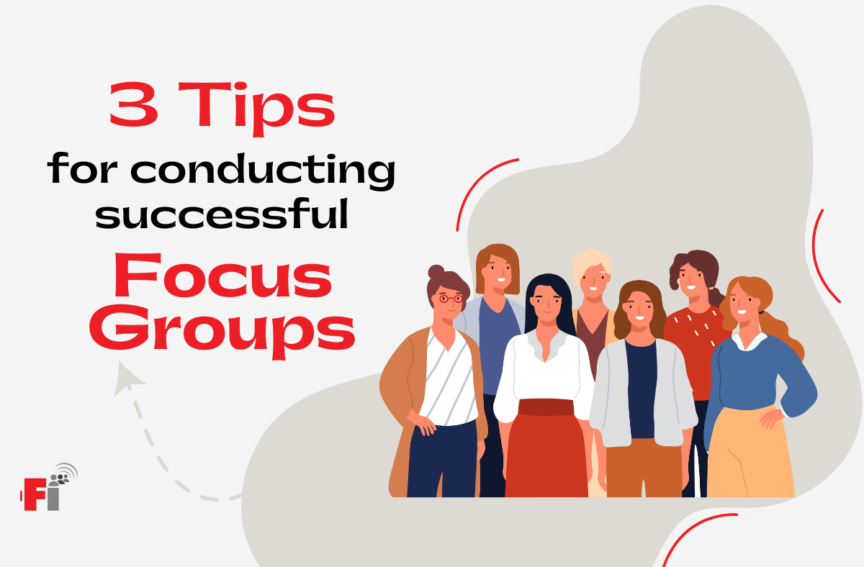Edited by Elizabeth Zuponcic
There are many methodologies utilized in market research, with focus groups arguably being the most well-known. Conducting focus groups are popular amongst market researchers because if well conducted and led by an experienced moderator, they offer up many rich insights into consumers’ behaviors. Just because researchers rely on focus groups for market research, doesn’t mean they are simple or easy to assemble. A lot of background planning must first be done to ensure a successful outcome.
As you work towards launching your market research study and elect focus groups as your research medium, here are three tips to consider for conducting successful focus groups.
Tip #1: Hold a focus group in a neutral space
If the goal of your focus group is to solicit feedback on your brand and you think you can host a focus group at your office, stop right there! Participant responses are more likely to be biased if they are aware of the company behind the research. You want participants to speak freely and not be swayed by pre-conceived notions they may have about a brand or product, which is why it is best to conduct focus groups in a neutral setting. If it is necessary to mention which brand or product for which the focus group is being conducted, then reserve this revelation for the very end of a focus group, so as not to bias the discussions.
Some options for neutral spaces are co-working spaces or hotel conference rooms. Wherever you end up hosting your focus group, keep your brand or product out of sight; this includes clothing with company logos or brand merch. When communicating with participants prior to the groups, use a non-company email. You’ll likely save money if you use an outside qualitative recruiting company to coordinate the recruiting and scheduling logistics, as this is a time-intensive part of setting up focus groups. This will also keep your company confidential, increasing the effectiveness of your focus group.
Tip #2: Develop a well-planned discussion guide
A well thought out discussion guide is the foundation of your focus group. The key word is “guide” and not “script”. You don’t want to feel locked in by your discussion guide because conversations will usually take unexpected turns that you want to allow. The design of the guide needs to be carefully thought through with your team. Before you create your discussion guide, first outline your goals for the project.
-
What do you hope to learn and solve?
-
Where are the opportunities?
-
Where are the gaps?
After you’ve sketched out your priorities, you can then structure the guide with these questions in mind.
Generally, you can expect to have time for three to four sections in a two-hour group, depending on how complex the topic is, of course. Write your questions out, going from general to specific, and keep them open-ended. Keeping your questions open-ended is especially important to avoid leading questions that may alter responses.
Whoever is conducting the focus group should memorize the guide. It’s not uncommon for participants to bring up points that come later in your guide. Rather than jumping all around, be prepared to follow their lead, and know where you should circle back. And finally, leave time for follow-up questions.
Moderating focus groups can be intimidating and you should consider hiring a professional qualitative research moderator. A good moderator is like a conductor. They are there to keep order and to bring out the best from each participant. To get the most out of your focus group, hiring a professional moderator will be well worth the investment.
Tip #3: Capture your data for later scrutiny
Our third tip is very important. Don’t conduct a focus group without capturing what is discussed. The amount of information that is shared in focus groups is not easily captured by a note-taker, as there are numerous side conversations that happen. Additionally, a note-taker can’t record body language or expressions. The best way to scrutinize data at a later time is to audio and video record the focus group sessions. A word of caution, however; a 2-hour focus group can easily yield up to 50-plus pages of transcript, and if you’re conducting multiple focus groups, you’ll be inundated by a lot of material. Once the focus groups are complete, you’ll want to budget one to two full weeks to properly synthesize and analyze the findings into a report for your team.
It is possible to conduct focus groups internally and on a lower budget, but a dedicated team of two or three senior-level employees to the study for three to four weeks will be necessary. Another note of caution if you don’t outsource focus groups to a neutral market research agency: your team will be essentially be wearing myopic “glasses” looking through the lens of their experiences with your brand, product, and processes. This position could negatively impact your market research results. You’ll get better outcomes by hiring a neutral, third-party agency to conduct your focus groups.
When you team with Focus Insite, you will benefit from the value focus groups have to offer. When you recruit high-quality recruits for your focus group, your collected insights will go further for your business. If you’re ready to learn more about how we can help you with your market research project, let us know here!
Updated on May 4, 2023: We are committed to providing our readers with the latest information and updating our previous articles as needed. We hope that you find this updated information informative and useful.


